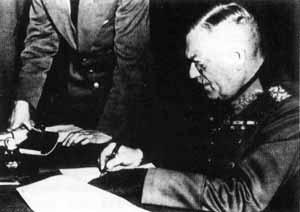Wilhelm Keitel

Wilhelm Keitel joins the army in 1901 and holds several posts during the First World War, serving primarily as an officer in the General Staff. After Germany falls in 1918, he pursues his military career at the heart of the new German army, the Reichswehr, as it was authorized by the Treaty of Versailles.
When Adolf Hitler came into power in 1933 and started rebuilding the armed forces, Wilhelm Keitel's career began to rapidly progress. He was named a brigadier in 1934 and the following year became chief of the War Cabinet and the director of the Wehrmachtsamt, in charge of the coordination of the armed forces. In 1938, Wilhelm Keitel became chief of the newly-created Oberkommando der Wehrmacht (OKW - Armed Forces High Command). On 22 June 1940, he signed the Franco-German armistice at Rethondes. This zealous executor of Adolf Hitler's orders was named chief of the OKW -- the Armed Forces High Command -- in 1938, and during the war authorized all Hitler's military decisions as well as the terror tactics he employed in countries taken by the Germans, most notably the execution of hostages and NN (Night and Fog) prisoners. He was promoted to Marshal in July 1940. Despite several attempts on the part of the leading circles of the army and the General Staff to shake up the top of the military hierarchy, he kept his positions until the end of the Second World War. On 9 May 1945, he signed the unconditional surrender of the Wehrmacht on the orders of Grand Admiral Doentiz. In 1946, the International Military Tribunal at Nuremberg condemned him to death for Crimes against Peace, War Crimes, and Crimes against Humanity.

